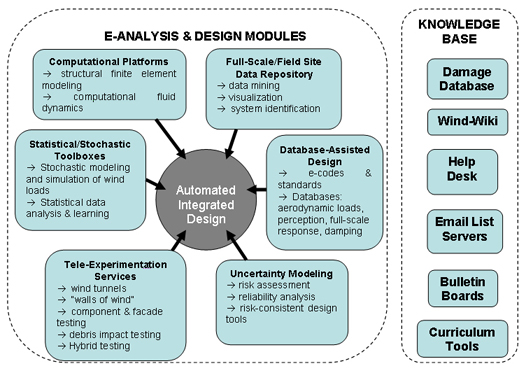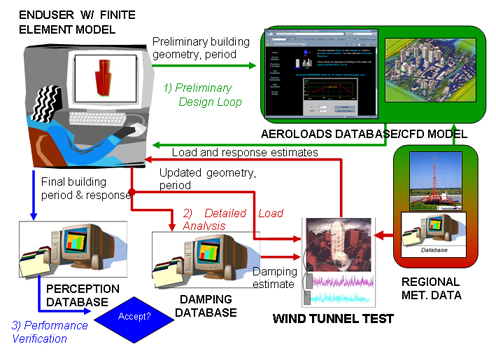Wind-related catastrophes inflict enormous devastation on the built environment and result in a staggering number of fatalities, which may continue to rise in the future given the increase in exposure as population migrates towards the coasts. To better manage the impact of extreme wind events, given the heavy reliance on empirical and experimental data in the design process, a new paradigm is required utilizing shared resources and global collaborations. An engineering virtual organization (EVO) would enable such a paradigm shift by offering real-time shared access to geographically dispersed resources for more effective research and education to achieve improved understanding and modeling of wind effects on structures. This report summarizes such a program initiated by the authors to develop an EVO that serves the international community under the sponsorship of the Global Center of Excellence at the Tokyo Polytechnic University.
Despite many advances in the area of wind effects on structures in recent decades, research has been conducted with limited resources scattered physically throughout universities, government, and private research laboratories as well as industry and trade organizations. With the trend toward increasingly complex designs such as free form architectures and the escalating potential for losses in coastal communities, the old paradigm is no longer optimal and requires the pooling of resources through a virtual organization reliant on cyberinfrastructure (CI). By centralizing tools and services within a flexible CI architecture to support research and education objectives in real-time, this synergistic, integrative approach offers efficacious tools that the community can use to minimize windstorm damage and meet the challenges posed by burgeoning emergence of wind-sensitive structures in expanding urban and suburban locales.
In order to mitigate escalating damage to property, loss of lives and disruption of local economies, a new research, teaching and design paradigm is proposed addressing wind effects on structures through the formation of a virtual organization utilizing integrated cyberinfrastructure technologies. Wind hazards would particularly benefit from this paradigm given the reliance on experimental and empirical data in the design process. The following sections detail a Virtual Organization for Reducing the Toll of EXtreme Winds (VORTEX-Winds), its overall vision and various levels of functionality of a prototype EVO under development. It encompasses real-time shared access to geographically dispersed resources, as well as providing a publicly accessible knowledge-base.
The basic vision of VORTEX-Winds is the development of a comprehensive gateway for research and education to achieve improved understanding and modeling of wind effects on structures to counter the escalating loss of property and associated indirect losses and the increase in the sensitivity of emerging structural systems in urban areas to winds. In response to this vision, the authors have established a virtual organization employing integrated cyberinfrastructure-based system that facilitates real-time, shared access to integrated design aids and services using geographically dispersed databases, specialized design/analysis tools, experimental facilities and full-scale monitoring networks, as well as providing a knowledge-base, with the following goals:
(i)To establish and sustain a community contributing to and employing the resources integrated by cyberinfrastructure technologies to facilitate the mitigation of escalating damage, loss of lives and disruption of local economies posed by wind;
(ii)To enhance analysis and design capabilities to address the challenges of innovative structural systems needed to realize, in a cost effective manner, buildings with ever increasing heights, bridges that span oceans, and offshore platforms tapping hydrocarbons in deeper waters exposed to weather extremes like hurricanes;
(iii)To facilitate education and training of the future workforce in the field so that the growing competition in the global market is met through a cadre of well trained professionals and educators.
The EVO structure is conceptually defined in Figure 1 as having two branches: the e-analysis and design modules and the Knowledge Base. The e-analysis and design modules are contributed from a number of universities, research centers and laboratories, based on their own independent work, and will be classified into six divisions. These six divisions are Database-Assisted Design, Full-Scale/Field Site Data Repository, Statistical/Stochastic Toolboxes, Tele-Experimentation Services, Uncertainty Modeling, and Computational Platforms. Examples of the modules offered within each of the divisions are also shown in Figure 1. The modules can be interrogated independently or automatically queried and input into an integrated analysis and design approach. In Figure 2, an example of an integrated analysis and design framework is presented.
The second branch of VORTEX-Winds is the knowledge base intended to aggregate and centralize the shared knowledge of the collaboratory. Services in this area include the virtual encyclopedia or wind-wiki encompassing basic terminology and concepts pertaining to wind-structure interaction, a damage database (curated archives of post-disaster reconnaissance), a help desk, where users can submit a question to the collaboratory and where past responses are archived as FAQs, bulletin boards hosting open discussions, email list servers for rapidly circulating announcements and other information, and curriculum tools to provide educators a means to formally integrate EVO services into their teaching. The knowledge base material will be broadly classified into 5 major areas: Engineering Micrometeorology; Aerodynamics/Aeroelasticity; Structural Dynamics; Experimental Methods; Performance Evaluation (encompassing Risk/Reliability and Codes/Standards).

Figure 1. Schematic of VORTEX-Winds Capabilities.

Figure 2. Schematic of Integrated Analysis and Design Concept.
The initial membership of the EVO has already been populated many of the world’s leading universities, research centers and laboratories specializing in wind effects on structures. A select group of end users and stakeholders have also been identified and will help to drive the services and features of the EVO and beta-test the prototype developed. These private sector end users are leading design firms, and the stakeholders include major professional organizations. In addition, an educational end user community has been assembled to evaluate the EVO’s suitability as an academic resource.
Through a collection of tools and services networked with a flexible architecture and interfaces to support research and education objectives in real-time, VORTEX-Winds promises to enhance the capability of each individual participant beyond their current resources through a synergistic, integrative approach to understanding and modeling the complex wind-structure interactions. The result will be a community as a whole better positioned to address the next frontiers in the field. Accordingly, VORTEX-Winds will serve as an end-to-end system that integrates global community resources related to wind effects on structures. It will facilitate an effective, transformative, and conveniently accessible venue for the acceleration of advances in research and development, as well as teaching and learning, in this area and would have a revolutionary impact on this field due to its unprecedented dissemination of knowledge and resources. |
